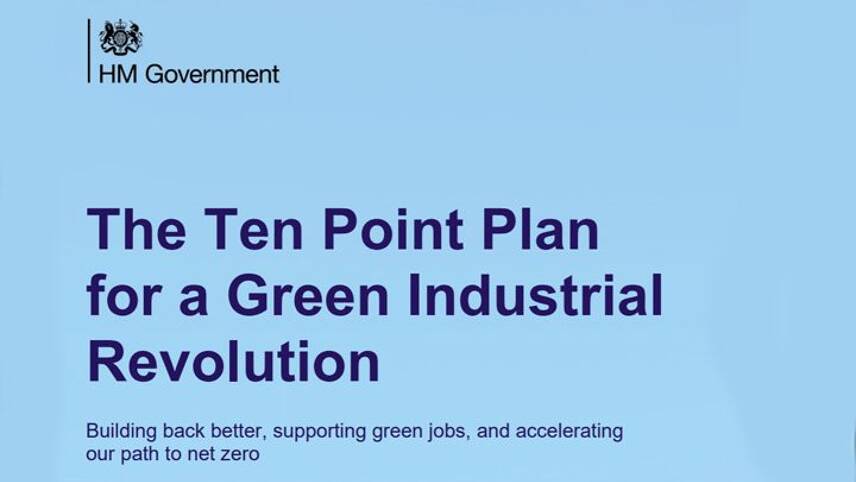Register for free and continue reading
Join our growing army of changemakers and get unlimited access to our premium content

The Government insists this is "only the start" of a green policy rollout
It was arguably the biggest green announcement of the year, dwarfing that of the green jobs package issued by the Government in the summer and the postponement of the COP26 climate summit.
Boris Johnson’s Ten Point Plan is aimed at eradicating the UK’s contribution to climate change by 2050, which has been enshrined into law as part of the net-zero emissions target. Clean hydrogen, carbon capture and storage (CCS), zero-carbon transport and offshore wind are all key pillars of the new package of promises.
The £12bn plan will support up to 250,000 green jobs, with the Government aiming to secure three times as much investment from the private sector by 2030. A key aspect of the plan is to “level up” all areas of the country, with industrial heartlands in the North East, Yorkshire and the Humber, West Midlands, Scotland and Wales all focal points of the strategy.
Initial reaction to the plan was one of optimism, with green groups describing the announcement as an “ambitious plan for a green industrial revolution”. As always with the Government, however, the devil is in the detail.
A new 38-page document has been released by the Government, going into more detail about the Ten Point Plan. Despite a more in-depth look at the low-carbon transition, the document somehow manages to raise more questions.
By the Government’s own admission, the Ten Point Plan would deliver a reduction in emissions of 180 million tonnes between 2023 and 2032, which is “equal to taking all of today’s cars off the road for around two years”.
It’s a promising start. However, analysis from Carbon Brief suggests that this translates to around 50% of the required emissions cuts to deliver on the Fourth and Fifth carbon budgets that cover those time periods. Those existing carbon budgets are tracked against the old Climate Change Act of an 80% reduction in emissions, rather than the net-zero target, and are expected to be updated. In fact, the Climate Change Committee (CCC) is expected to publish advice on future carbon budgets in December.
According to the Government, the Ten Point Plan would deliver the following boost to green jobs, cuts to emissions, and investment levels:
Offshore wind would support up to 60,000 jobs in 2030 and attract £20bn of private investment. This would deliver savings of 21MtCO2e between 2023 and 2032, or 5% of 2018 UK emissions.
Hydrogen deployment would support up to 8,000 jobs by 2030, potentially unlocking up to 100,000 jobs by 2050 and attract £4bn of private investment. This would deliver savings of 41MtCO2e between 2023 and 2032, or 9% of 2018 UK emissions.
Advance nuclear would support a peak of around 10,000 jobs during construction and could attract up to £300m for development of small modular reactors alone. There are now decarbonisation figures listed for nuclear, but the Government adds that “each GW of nuclear power generation is enough to power two million homes with clean electricity”.
Electric vehicles would support 40,000 new jobs in 2030 and attract £3bn of private investment by 2026. This would deliver savings of around 5MtCO2e to 2032 and 300MtCO2e to 2050.
Decarbonising public transport would support up to 3,000 jobs by 2025 with Government investment reaching £5bn in buses, cycling and walking this parliament. This would deliver savings of around 2MtCO2e from green buses, cycling and walking between 2023 and 2032.
Aviation and shipping would support up to 5,200 jobs to “future proof” the aerospace industry which is worth £12bn to the economy. This would deliver savings of up to 1MtCO2e by 2032 from clean maritime and nearly 15MtCO2e by 2050 from aviation.
Green buildings would support around 50,000 jobs in 2030, attracting £11bn of private investment. This would deliver savings of 71MtCO2e between 2023 and 2032, or 16% of 2018 UK emissions.
Carbon Capture and Storage would support 50,000 jobs, attracting up to £1bn of public investment by 2025. This would deliver savings of around 40MtCO2e between 2023 and 2032, or 9% of 2018 UK emissions.
Nature would support 20,000 jobs from improving flood defences by 2027, attracting £5.2bn of investment. No figures listed for carbon reductions or savings.
Green finance has the “potential” for hundreds of thousands of jobs by 2030, attracting £1bn of government funding in net-zero innovation with £1bn of matched funding and potentially £2.5bn of follow on funding from the private sector.
‘Only the start’
The Government is adamant that the Ten Point Plan is not the end-point for green policy aimed at the net-zero transition.
“This is only the start,” the report states. “Over the next year, we will work with industry to devise further sectoral plans and meet our carbon budgets and target of net-zero by 2050. To drive our progress towards this national priority, the Prime Minister will establish a new Task Force Net Zero, putting a systems approach at the heart of our thinking.”
Green groups and businesses are still awaiting the Spending Review, the Energy White Paper, National Infrastructure Strategy, the Heat and Buildings Strategy and a committed Hydrogen Strategy – all of which could emerge imminently or in 2021.
It is likely these strategies, along with updated carbon budgets and a new, net-zero aligned Nationally Determined Contribution (NDC) to the Paris Agreement in the build-up to COP26 could transform sectoral approaches to decarbonisation, and put the UK on track for net-zero by 2050.
Matt Mace


Please login or Register to leave a comment.